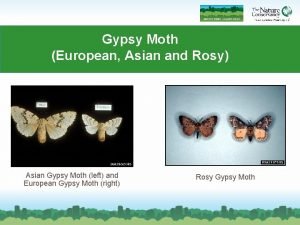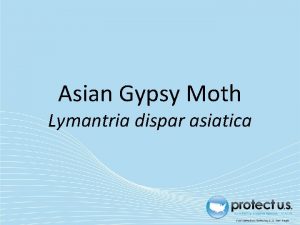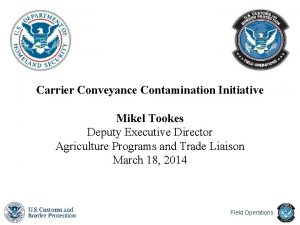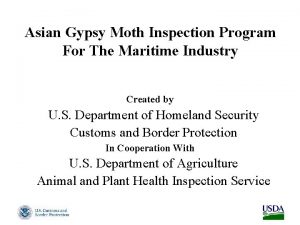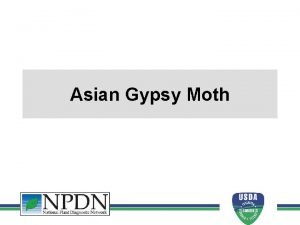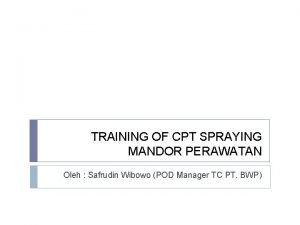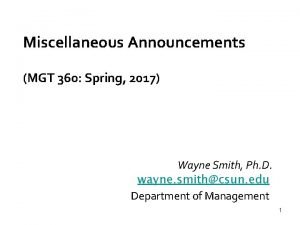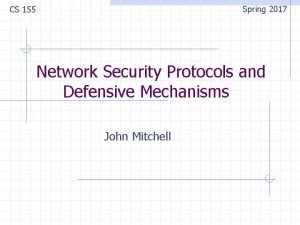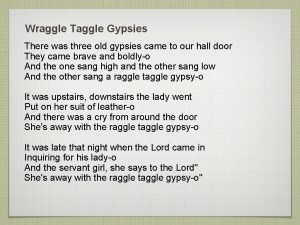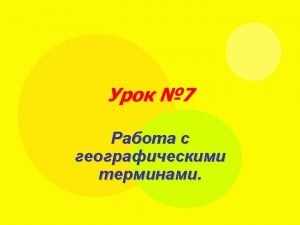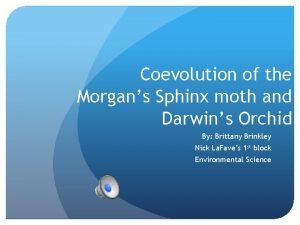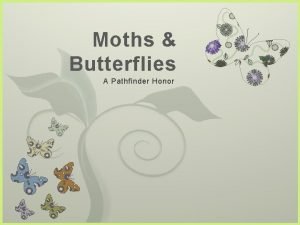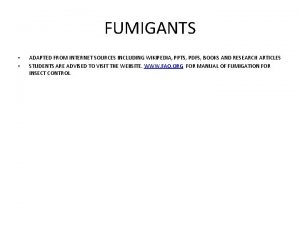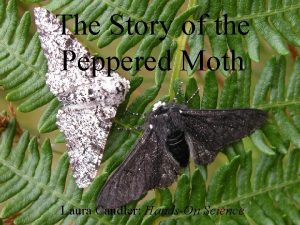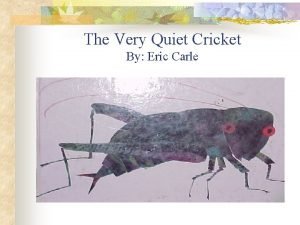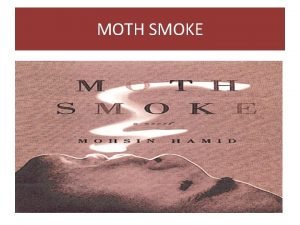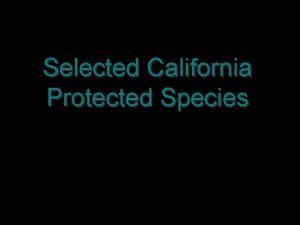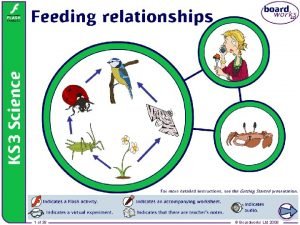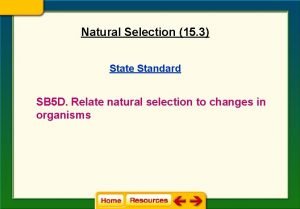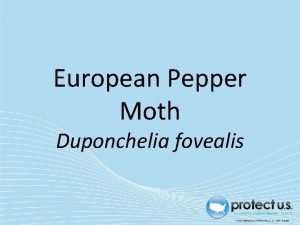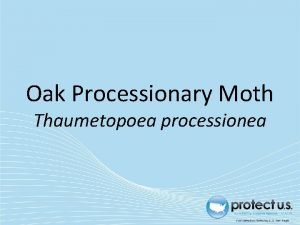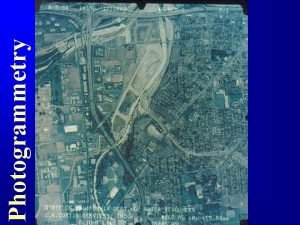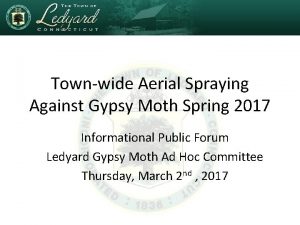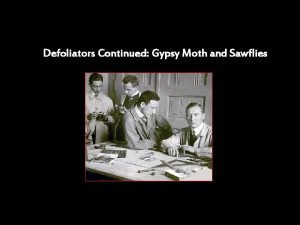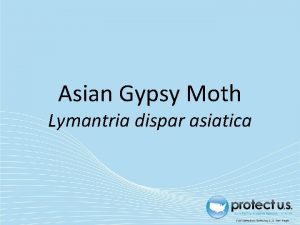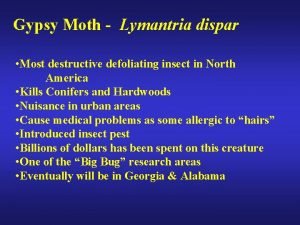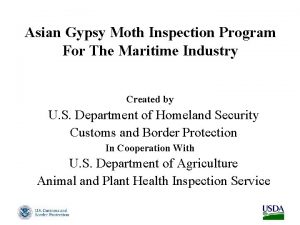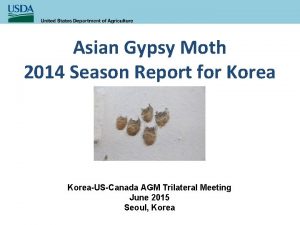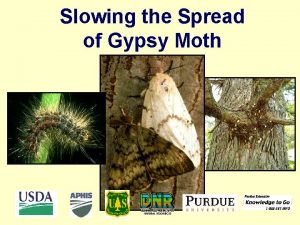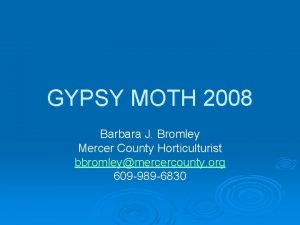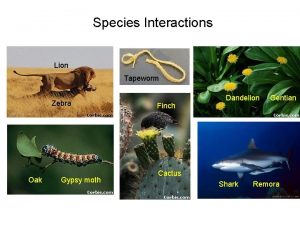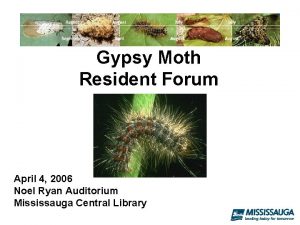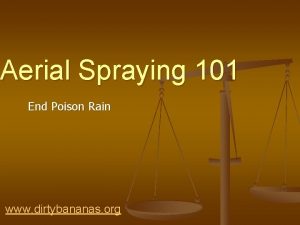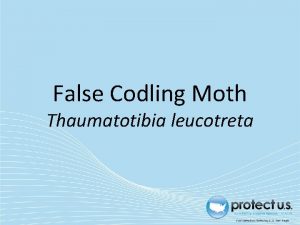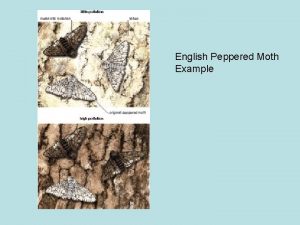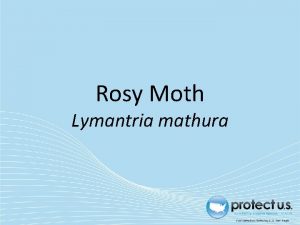Townwide Aerial Spraying Against Gypsy Moth Spring 2017






































- Slides: 38

Town-wide Aerial Spraying Against Gypsy Moth Spring 2017 Informational Public Forum Ledyard Gypsy Moth Ad Hoc Committee Thursday, March 2 nd , 2017

Presentation Outline Q&A Btk Aerial Spraying Btk Mechanism & Health Risks Gypsy Moth Basics

Gypsy Moth Basics Biology & Introduction As Invasive Species

Gypsy Moth - Lymantria Dispar • Introduced insect pest in 1869 from Europe • Intent of interbreeding with silk worms to develop a silkworm industry • Most destructive defoliating insect in North America • Larvae consume the leaves of over 500 species of trees, shrubs and plants • Billions of dollars have been spent on this creature E. Leopold Trouvelot

Spread Of Gypsy Moth 2013 1900 1965 1934 1995

CT 2015 Ledyard

New England 2016 June May Ledyard

New England 2016 Ledyard Brown areas on this map indicate areas where the forest greenness is much different than its expected greenness for the given date. These areas have very likely been damaged by gypsy moths. Image credit: Pasquarella et al. Amherst University

Gypsy Moth Life Cycle

Food Sources Likes • Oak • Maple • Elm • • • Apple Alder Birch Poplar Willow • Pines • Spruces Oak Tree • • • Dislikes Ashes Sycamores Butternuts Black Walnuts Dogwoods Balsam fir Cedar American Holly Rhododendron Azalea

Impact

Impact Of Doing Nothing • Develop rashes or other skin irritation • Irritation to the eyes or respiratory tract • Infestations can induce stress in individuals • Caterpillars and their droppings can make roads and walkways slippery • Falling limbs can pose a hazard when trees die as a result of defoliation • Economic costs include loss of tourism and reduction in property values • Cost to cut down dead trees, repainting buildings, pruning trees, and replacing dead trees and shrubs

Environmental Impact Of Inaction • Trees killed as a result of defoliation • Large-scale starvation of other moths and butterflies • Decline of gray squirrel and some bird species • Woodpecker populations might increase • Nesting failures of grouse and turkey may increase • Change in tree composition of forests • Increase in water temperature of small streams • Increase in algae growth

Gypsy Moth Control Options Tree Banding Sticky Barrier Pheromone Traps Ground Spraying Aerial Spraying

Bacillus Thuringiensis Kurstaki (BTK) Information Mechanism of Action, Human Health & Environmental Impact

Bacillus thuringiensis kurstaki (Btk) • Common soil bacterium • Biological insecticide • Not a chemical pesticide • Readily breaks down in the environment • Produces proteins that are toxic to caterpillars • Commonly used in garden sprays & for commercial agriculture • Commercial formulations of Btk (e. g. Foray 48 B) used in organic farming • Extremely well-known toxin in terms of human health & environmental safety

Joerg Graf m. Bio 2011; doi: 10. 1128/m. Bio. 00161 -11 Schematic Of B. Thuringiensis Toxin Mode Of Action Binding 1. Insect eats Btk crystals and spores. 2. The toxin binds to specific receptors in the gut and the insects stops eating. 3. The crystals cause the gut wall to break down, allowing spores and normal gut bacteria to enter the body. 4. The insect dies as spores and gut bacteria proliferate in the body.

Btk-Human Health Assessment I • Not a human pathogen • Not pathogenic for immuno-compromised people or those on stomach acid-suppressing medication • δ-endotoxin is not active in mammalian gut and has no other known effect on mammals • The inert ingredients in commercial formulations (e. g. Foray 48 B) are used in cosmetics and foods • Some people may experience minor eye, nose, throat and respiratory irritation • Unlikely to cause allergic reactions • The unpleasant smell may cause nausea, headache

Human Health Assessment II • No adverse effect during pregnancy on either mother or fetus • F 48 B exposure does not cause sytemic toxicities • Spray programs can cause considerable anxiety • No known or suspected carcinogens and mutagens in the ingredient list • Noise from low flying aircraft can be annoying and could produce anxiety in people • Regulatory agencies recommended a precautionary approach for reducing exposure

Environmental Concerns • Btk is non-toxic to bees • Does not affect beetles, sucking insects or spiders • Does not affect earthworms and other invertebrates • Is expected to kill exposed early instar caterpillars; no impact on adult caterpillars • No risk for mammals, birds and fish • Little information for amphibians or reptiles

Ad Hoc Gypsy Moth Committee Overview, Timing And Cost Of Aerial Spraying, Consent And Objections

Ad Hoc Gypsy Moth Committee Timeline JUL 2016 AUG 2016 OCT 2016 DEC 2016 • Parsonage Hill Manor neighborhood presents gypsy moth issue to town council • Town council signs resolution for a gypsy moth ad hoc committee • Gypsy moth ad hoc committee has first meeting with incomplete member slate • Pre-application meeting with Connecticut DEEP • DEEP suggests focusing on one neighborhood and proposes helicopter spraying JAN 2017 • Gypsy moth ad hoc committee proposes to focus on a pilot program for aerial spraying of one neighborhood FEB 2017 • Company from Long Island accepts job for helicopter spraying • Town council rejects pilot program, wants program for the whole town

Aviation Company • North Fork Helicopters Ltd • 830 Sterling Lane • Cutchogue, NY 11935 -2336 • *Speak to Raymond Finney • (631) 734 -5515 Aerial Spraying of Bacillus thuringiensis in Ledyard, 1985 • Email: 47 agcopter@gmail. com Picture: The Gypsy Moth, Kirby C. Stafford III The Connecticut Agricultural Experiment Station (www. ct/gov/caes)

Cost The Feds will not pay for spraying The state will not pay for spraying The town will not pay for spraying Property owners are responsible for the cost • Current cost estimate is $350 per acre • Cost might come down • •

What if I do not want spraying? • Fill out form that you are opposed to aerial spraying • Any neighbor who wants spraying cannot spray within 200 feet of your property line • If you are not opposed to spraying but just don’t want to pay for it, the 200 foot rule does not apply • Keep in mind that aerial spraying will be less effective when property owners do not participate

What If I Do Want Spraying? • Any neighborhood can file a permit with CT DEEP as long as there is more than 10 acres • You can find a permit at http: //www. ct. gov/deep/lib/deep/Permit s_and_Licenses/Waste_Permits/aerial_ins t. pdf • It is not easy to find a company with aerial pesticide application permit in CT • It will be hard to find an aerial spraying applicator company below 100 acres

Why Aerial Spraying Might Not Happen • Too many people object to spraying • Too many people cannot afford spraying • Application submitted too late or incomplete • CT DEEP rejects application – Concern over endangered species act – Concern over waterways • Weather conditions do not allow for aerial spraying • [Wet spring wipes out gypsy moth population]

What If I Want Ground Spraying? 1)Bartlett Tree Experts 45 Plains Road Essex, CT 06426 (860) 767 -1752 Speak to Diana • Nicholas Vallas is ISA Certified Arborist • nvallas@bartlett. com • (860) 572 -6070 2)Yankee Tree Old Lyme, CT 06371 Jon Parker (860) 434 -8733 Arborist/3 A #S-2650

Advanced Notice • • Spraying will likely take place in May PSA’s – Public Service Announcements Local News Radio Stations Social Media Town Website Sign up for town notifications

Questions?

Egg Masses

Egg Masses Female lay egg masses on tree trunks or other vertical objects. An egg mass contains 100 – 1500 eggs which are the overwintering stage.

Eggs Hatch Eggs hatch the following spring. Gypsy Moth first instar larvae

“Ballooning” Larvae emerge in Mid. April and disperse by “ballooning” Have very long “hairs” are easily airborne

Larvae Instars 4 -6 feed on new foliage first and then move on to older foliage if necessary

Mature Gypsy Moth larvae are large insects and one can eat several leaves a day.

Pupae Gypsy Moths often pupate on tree trunks. Pupae are found in June and July which lasts about 2 weeks. Pupal case

• Adults emerge, find each other and the cycle continues • One generation per year • Females do not FLY
 Gypsy moth
Gypsy moth Gypsy moth caterpillar
Gypsy moth caterpillar Asian gypsy moth vessel inspection
Asian gypsy moth vessel inspection Asian gypsy moth inspection
Asian gypsy moth inspection Gypsy moth caterpillar
Gypsy moth caterpillar Gypsy moth population
Gypsy moth population Electrostatic meter chapman
Electrostatic meter chapman Nozzle vlv 200
Nozzle vlv 200 Wayne smith csun
Wayne smith csun Ftp server spring 2017
Ftp server spring 2017 Kim ki duk spring summer fall winter
Kim ki duk spring summer fall winter Summer autumn winter spring
Summer autumn winter spring Brian peters raggle taggle gypsy
Brian peters raggle taggle gypsy River gypsy
River gypsy British pussy xxx
British pussy xxx Hristo kyuchukov
Hristo kyuchukov River gypsy in bangladesh class 8
River gypsy in bangladesh class 8 Henri rousseau sleeping gypsy analysis
Henri rousseau sleeping gypsy analysis Scholar and gypsy by anita desai summary
Scholar and gypsy by anita desai summary Vik muniz pictures of garbage: the gipsy (magna)
Vik muniz pictures of garbage: the gipsy (magna) Gypsy ballads
Gypsy ballads Jeopardy gypsy answer
Jeopardy gypsy answer Travellers surrey
Travellers surrey Morgans sphinx moth
Morgans sphinx moth Moth scale
Moth scale Pathfinder moth
Pathfinder moth Ethereal moth wikipedia
Ethereal moth wikipedia Moth black and white
Moth black and white The little cricket
The little cricket Moth smoke sparknotes
Moth smoke sparknotes Kern primrose sphinx moth
Kern primrose sphinx moth Name the producer in the food chain.
Name the producer in the food chain. Peppered moth
Peppered moth European pepper moth
European pepper moth Beetle aphid bird food chain
Beetle aphid bird food chain Moth
Moth Oak processionary moth life cycle
Oak processionary moth life cycle Vertical aerial
Vertical aerial Usda farm service aerial maps
Usda farm service aerial maps
